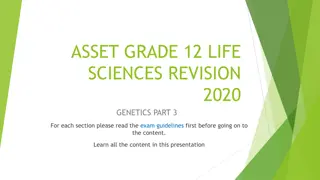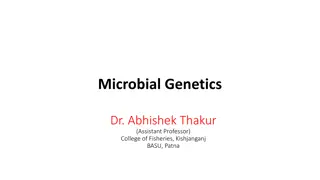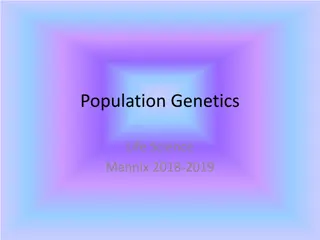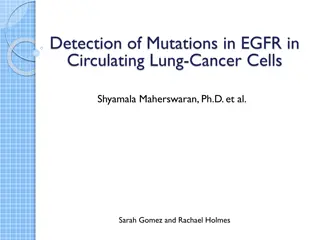Understanding Mutations: Types, Characteristics, and Examples
Mutations are changes in the genetic material that can affect an organism's traits. This article explores gene mutations, their historical background, characteristics, kinds of mutations like spontaneous and induced, somatic and germinal mutations, and conditional lethal mutations. It also covers general features of mutations, such as their randomness, harmfulness, and frequency in nature.
Download Presentation

Please find below an Image/Link to download the presentation.
The content on the website is provided AS IS for your information and personal use only. It may not be sold, licensed, or shared on other websites without obtaining consent from the author. Download presentation by click this link. If you encounter any issues during the download, it is possible that the publisher has removed the file from their server.
E N D
Presentation Transcript
B.Sc B.Sc II Paper II Unit 3 II Paper II Unit 3rd rd MUTATIONS MUTATIONS Dr. Sanjay Srivastava Botany Department Harish Chandra P. G. College Varanasi Mobile: 9415635846 Email: sanjaychandravns@gmail.com
Mutations cover those changes that alter the chemical structure of gene at the molecular level. These are called gene mutations or point mutations. Hugo de Vries used the term mutations to describe phenotypic changes that were heritable. Although the gigas mutant in Oenothera lamarchiana on which this assumption was based was later found to be due to polyploidy. Seth Wright (1791) was the first to describe germinal mutations in domesticated animals Ancon breed (short legged) in sheep. Scientific study of mutations was started in 1910 by MORGAN with experiments performed on Drosophila melanogaster. He observed a rare white eyed male among a population of red eyed males. Mutation studies in other organisms such as maize, snapdragon, rodents and man etc. have also yielded good results. Later, it was discovered that microorganisms such as Neurospora (fungus), Escherichia coli (bacterium) and bacteriophages (virus) could serve as a better tool (test organism) for research on mutation. The reason for this being, these organisms have simple organization of genetic material, their several generations could be obtained and observed in shorter span of time and also because they could be easily cultured in laboratory.
+/w w/- Red eyed female White eyed male w/w w/+ w/- +/- White eyed Red eyed White eyed Red Eyed
General characteristics of Mutations : . 1. Mutations are generally recessive (exception- epiloia and achondroplastic dwarfism in man, Notch wing in Drosophila). 2. Mutations are random. 3. They are mostly harmful (only 0.1% useful). 4. They may be recurrent. 5. In nature occur at very low frequency i.e. rate of spontaneous mutations is low and varies from gene to gene (highly stable gene- waxy locus in maize and highly unstable gene- yellow body colour in Drosophila. 6. Mutable genes are those which have a mutation rate higher than usual. 7. Mutator gene increases the rate of mutation throughout an organism s genome by inhibiting DNA repair functions. 8. Anti-mutator gene is a mutant gene that decreases the rate of mutation. 9. Hot Spots are highly mutable sites within a gene.
KINDS OF MUTATIONS: Spontaneous Mutations: Mutations that arise naturally and not due to exposure to certain mutagens are called spontaneous mutations. Examples - mutations arising due to errors during DNA replication or due to Induced Mutations: Mutations that are artificially introduced with the help of mutagenic agents are called induced mutations. Somatic Mutations: If mutation occurs in a somatic cell i.e. any cell other than the germ or reproductive cell,e.g. delicious apple and navel oranges. Germinal Mutations: Mutations that occur in germ cells, e.g. dominant germinal mutation Ancon breed in sheep. Conditional lethal Mutations: There are certain mutations that are lethal in a specific condition (restrictive condition) but in other condition (permissive condition) they are viable. Mutants which carry conditional lethal mutations are of three types: i) Auxotrophic mutants ii) temperature sensitive mutants iii) suppressor sensitive mutants Auxotrophic mutants are not able to synthesize a particular metabolite. They are not able to grow in the absence of that metabolite but grow if the particular metabolite is supplied. Temperature sensitive mutants are not able to grow at a particular temperature but can grow at other. Suppressor sensitive mutants are able to grow in the presence of a suppressor but cannot grow in its absence.
Sickle cell anaemia develops due to a mutant haemoglobin called sickle cell haemoglobin (haemoglobin S) found in some individuals. Individuals homozygous for haemoglobin S allele (Hb s/Hb s) develop severe haemolytic anemia. As haemoglobin S precipitates and forms crystals in deoxygenated state, the red blood cells carrying it elongate and become sickle shaped. Normal haemoglobin found in human is haemoglobin A. subscript is used because haemoglobin S is a variant of beta chain. The chain of the two types of haemoglobin i.e. A and S was compared. It was found that the two haemoglobin differ only in one amino acid. In normal haemoglobin, the sixth amino acid from NH2 terminal end is glutamic acid. In haemoglobin S, in place of glutamic acid valine is present. Pleiotropy is the phenomenon in which a single gene affects more than one character. Hb s allele is a typical example of pleiotropy. .This allele not only causes haemolytic anaemia but also provides increased resistance to certain type of malaria that is caused by a parasite Plasmodium falciparum in individuals carrying it.
Back and suppressor mutations A wild allele mutates to form a mutant allele. This is called forward mutation. If due to a subsequent mutation the original wild type phenotype is restored then it is called back mutation or reverse mutation or simply reversion. Reverse mutation may be the result of a mutation occurring in the same allele at the same site. Reversion may also result from a mutation occurring at some other location in the genome which somehow neutralizes the effect of forward mutation. Neutral Mutations are those changes in DNA sequences which are neither beneficial nor harmful to the ability of organisms to survive or reproduce. Silent Mutations are those changes which do not significantly alter the phenotype of the organism, e.g. mutations occurring in INTRON sequences or if occurring in EXON sequences, then synonym mutations ( codon AAA and AUG both code for lysine). Spurious Mutations when recessive genes appear phenotypically by crossing over it is called spurious mutation. They are generally hidden mutations, e.g. pink eye colour in Drosophila.
Molecular basis of mutation:Watson and Crick gave the double helical model of DNA According to them DNA replicates in semi-conservative manner.This mode of replication is nearly full proof and minimises chances of error. But still errors do occur and result in spontaneous mutations. Nitrogenous Bases according to them exist in their normal state as Keto and amino form. But shifting of H atom from amino groups to ring nitrogen sometimes occurs. This is called tautomerism or tautomeric shifts. The more stable ketoform of thymine and guanine rarely undergo tautomeric shift and convert to less stable enol form. Similarly amino form of adenine and cytosine change into imino form. In enol and imino forms, bases undergo adenine-cytosine and guanine-thymine pairing. This mismatched base pairing finally results into A-T base pair converting into G-C base pair or G-C into A-T base pair substitution. Such type of changes in which a Purine changes into another Purine and a Pyrimidine changes to another Pyrimidine are called TRANSITION changes. But another type of change in which a Purine changes into a Pyrimidine and vise-versa, also takes place. Such changes are called TRANSVERSION changes. Both transition and transversion are BASE PAIR SUBSTITUTION reactions i.e. a base pair is replaced by another base pair. Besides this, DELETION and ADDITION of bases also occurs. These come under FRAME SHIFT MUTATIONS as the entire frame of codons ahead of deleted or added base is changed.
T AG C A and G = Purine ; T and C = Pyrimidine Transitions (four possible types) Transversions (eight possible types)
Induced mutations are those which are artificially introduced with the help of mutagenic agents which have been classified into two categories. 1. Physical Mutagens 2. Chemical Mutagens 1. Physical Mutagens: include radiations (portion of electromagnetic spectrum containing wave lengths shorter than visible light and thus having higher energy), change of pH, temperature shocks. RADIATIONS Non-ionizing RadiationsIonizing Radiations - Uv Rays, infrared, microwaves, radiowaves Electromagnetic RaysCorpuscular Rays -X Rays -Gamma Rays -Beta Rays (electron) -Protons(H nucleus) -Neutrons -Alpha Rays(He particle)
Inverse relationship exists between wave length and penetrance of radiations i.e. more the wave length lesser will be the penetrance and similarly lesser the wave length more will be the penetrance. Ionizing radiations have lower wave length and therefore more penetrance power. Ionizing radiations when fall on a substance, release electrons from the atoms (Ionization). Non-ionizing radiations such as Uv rays due to their low energy do not cause ionization. They only transfer their energy to electrons which leave their orbital and reach a higher energy state i.e., excited state (a highly reactive state). Non-ionizing radiations: Uv rays: Don t have enough energy to bring about ionization. Due to lesser penetrance, can enter only surface layer of cells in multicellular organisms. Its exposure can lead to skin cancer in human beings. Thus Uv rays show their mutagenic effect only in unicellular organisms. They are easily absorbed by purine and pyrimidine. Strong absorption of Uv rays is observed in pyrimidine particularly thymine. Thymine dimerization occurs due to Uv absorption. Thymine dimer interferes with precise DNA replication. DNA Repair: Photoreactivtion, excision repair, postreplication recombination repair.
Ionizing radiations: H.J.Muller (1927) Sex linked recessive lethal mutations in Drosophila melanogaster. Muller developed the CLB method, a cross in Drosophila through which one can identify whether any lethal mutation has been introduced due to X ray exposure or not. C = crossover suppressor; l = recessive lethal; B = partially dominant mutation that causes Barred eye (narrow eye). The mutagenic effect of X ray in maize and barley was demonstrated by L.J.Stadler (1928). X rays and other types of ionizing radiations are quantified in roentgen units (r units). Rem(Roentgen equivalent man) = it is the unit of radiation dosage applied to humans. X ray obtained from X ray machine Gamma ray obtained from Cobalt 60 and Cesium 137 Beta rays obtained Phosphorus Neutrons obtained from nuclear reactor
CHEMICAL MUTAGENS: Charlotte Auerbach discovered that mutations could be introduced chemically also. She observed it during World war II. Chemical mutagens: mustard gas, ethyl urethane, phenol, formaldehyde, lysergic acid, ethyl methane sulphonate (EMS)
MUTATIONS (molecular level) 1. Deletion of bases 2. Insertion of bases breakage & reunion 3. Inversion of base sequence 4. Replacement of base pair (during replication) Transition Transversion A G A C T C T G T G A C
1.Effect of chemical mutagens on nucleotide sequence During replication In resting nucleic acid a) Nitrous acid b) Hydroxyl amine and hydrazine c) Alkylating agents Incorporation Inhibition Of base analogue of nucleic acid precursor Incorporation of base analogue: 5-Bu, 5-Cu, 5-Iu, 2 AP Inhibition of nucleic acid precursor: Azaserine inhibits purine synthesis, Urethane inhibits pyrimidine synthesis Nitrous acid: deaminates G,C,A with diminishing frequency
Hydroxyl amine and hydrazine: Cytosine Hydroxyl amine hydroxylcytosine (pairs with adenine) Hydrazine breaks rings of uracil and cytosine Alkylating agents: carry 1 or 2 reactive alkyl groups e.g. DES, DMS, MMS, EES, EMS These can bring about alkylation of phosphate groups, hydrolysis of triester between sugar and phosphate , alkylation of bases and depurination.
2. EFFECT OF PHYSICAL CONDITIONS: i) Low pH: Some bases get positively charged and the strands separate. ii) High Temprtature: Strand separation occurs iii) Radiations: portion of electromagnetic spectrum containing wave lengths shorter than visible light and thus having higher energy. They are of two types- Ionizing (break chromosomes which depends on the type of cell and stage of nuclear cycle) and nonionizing radiations (do not cause ionization, only excitation, penetrate only surface layer of cells)
Mutations and Evolution: Variations are the raw materials for evolution. Evolution definitely depends on MUTATION because mutation is the only way by which new genes are created. But the main hurdles facing the explanation of the hypothesis are as under: most mutations are harmful or neutral (encoding the same aminoacid). most mutations occur in the noncoding part of DNA. effect single protein product but evolution involves many changes in proteins. Probable Solutions: If the genes are present in paired state, as occurs in diploid organisms then one gene (allele) may undergo mutation. The other gene being normal, the mutant may well be tolerated by organism. Now, in due course of time the mutant gene may undergo changes to produce a beneficial phenotype. Then mutations occurring in regulatory regions can help in evolution. Similarly mutations occurring in noncoding section of DNA can also go the same way. THANK YOU























